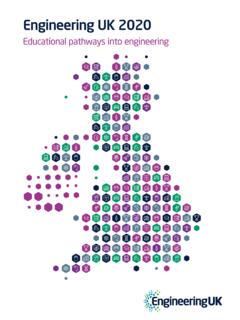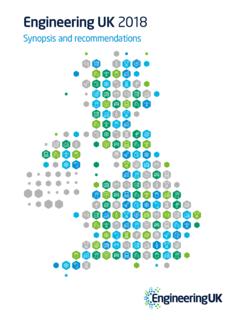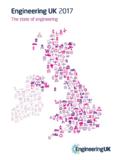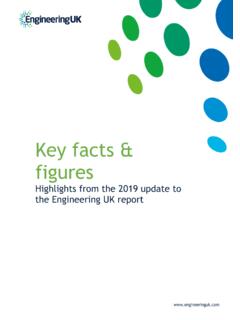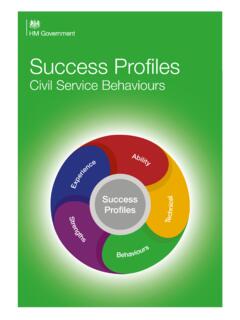Transcription of Gender disparity in engineering
1 EngineeringUK briefingGender disparity in engineeringExecutive summary ..3 Women in the engineering workforce ..4 The business case for Gender representation ..5 Case study: Cummins approach to Gender balanced recruitment ..5 Progression along the STEM skills pipeline ..6 Barriers to Gender representation ..9 Case study: UCL s 50:50 engineering engagement strategy ..14 Looking beyond education ..15 Think piece: Royal Academy of engineering - Widening routes into engineering ..16 The potential for STEM engagement activity to inspire the next generation of female engineers ..18 EngineeringUK briefing: Gender disparity in engineering ContentsTo find out more about EngineeringUK and the research we conduct, visit: 3 Gender disparity in engineeringWomen remain severely underrepresented in engineering : just 12% of those working in engineering are female, compared with 47% of the overall UK workforce, despite concerted efforts over many years to address this imbalance.
2 This disparity is largely a consequence of the rates of female participation in the engineering educational pipeline. Girls perform better academically in most GCSE and A level STEM subjects than boys and are more likely to progress into higher education generally; yet relatively few decide to study STEM at A level and even fewer progress onto engineering apprenticeships or studies suggest the low participation of girls in engineering in par t reflects Gender differences in understanding of and interest in the profession, as well as perceptions of self- ef ficacy and identity. Among the young people we sur veyed in our engineering Brand Monitor (EBM) perceptions of and aspirations to the engineering profession were significantly lower among girls than boys. Girls were less likely to feel they could become an engineer if they wanted to; to think that being an engineer would fit well with who they are; or to consider a career in engineering .
3 They were also more likely to describe the profession as too complicated or dif ficult , dir ty, greasy or messy and a career for men than boys. Strikingly, many of these differences were observed among children as young as 7, suggesting that such perceptions and aspirations are formulated at an early age, well before young people make key decisions about their educational choices. For those who continue their STEM studies there are Gender differences in the career paths they follow. Six months after graduating, male engineering and technology graduates are more likely to go on to work in an engineering - related role or find employment in the engineering sector than their female counterpar ts. Likewise, issues of retention and pay gaps are evident between women and men working in engineering occupations. Executive summaryThese findings clearly show more work is needed to inform young people, especially girls, about what a career in engineering can entail and to improve the image of the profession.
4 Not only are there social justice reasons for encouraging greater Gender parity in engineering , there is a compelling business case for a more representative workforce. Myriad studies demonstrate that diversity in the workforce yields greater creativity and innovation and improved business performance. And as our latest report, engineering UK 2018: The state of engineering , estimates, ever y year there is a shor tfall of between 37,000 and 59,000 people to meet demand for Level 3+ core engineering It is therefore essential that the engineering and educational communities and government engage with young people especially girls to cultivate and sustain their interest in engineering , and demonstrate that it is a profession for ever briefing provides an overview of female underrepresentation in engineering , both those coming through the education and training pipeline into the profession and those working as engineers.
5 It includes findings from our engineering Brand Monitor, a national survey of young people and the public more generally into their knowledge, perceptions and understanding of the profession, to provide some insight into this Gender Level 3 qualifications are those that demonstrate completion of secondary school or equivalent and are required to work in qualified/skilled employment or for entry to higher education. Level 3 qualifications include, but are not limited to: GCE A or AS levels, Access to HE diplomas, Welsh Baccalaureate Advanced qualifications (Wales), Level 3 and/or Junior Certificates ( ireland ), National 3, NPA or National Certificate Awards (Scotland), and certain technical and vocational qualifications. For more information, please see engineering UK 2018: the state of engineering annex . A level Physics entrantsEngineering and technology first degree entrantsEngineering apprenticeship starts (England only)50%22%16 %8%GCSE Physics entrantsProportion female4 Gender disparity in engineering Women in the engineering workforceIt is clear that the Gender composition of engineering workers does not reflect that of the overall working population.
6 According to our analysis of the Labour Force Sur vey, just 12% of those working in engineering occupations in 2016 were women, compared with 47% of the overall UK propor tion was even lower when considering just those working in engineering occupations within the engineering sector, at 9%. In contrast, 19% of engineers working outside of the sector were women, suggesting that industries not traditionally associated with engineering such as health, ar ts, enter tainment and recreation are more successful in attracting female engineers into the workforce. While this briefing considers women in engineering roles and the impor tance of increasing their representation, it is also evident that women are underrepresented more broadly in engineering companies, making up just 21% of all employees in the sector. This indicates that although the issue is par ticularly acute among those working in engineering occupations, there is a wider problem of Gender underrepresentation in the engineering sector as a whole.
7 This Gender imbalance has clear implications not just for the immediate workforce, but also the ex tent to which girls are likely to be attracted to the profession in the future. According to a UK study by Microsof t, 70% of girls sur veyed said they would feel more confident pursuing STEM careers if they knew men and women were equally employed in these professions,2 and the lack of visible female role models on girls career choices is well evidenced in existing Figure 1 Gender composition of the workforce in 2016 UK engineering workforce in engineering sector59%91% engineering workforce outside of engineering sector319%81%FemaleMaleEngineering workforce - any sector412%88%Workforce in engineering sector - any role221%79%UK workforce147%53%2 Education Technology. Why aren t more girls in the UK studying STEM subjects? , March 2017. 3 Microsoft. How role models are changing the face of STEM in Europe, April 2018; Young et.
8 Al. The influence of female role models on women s implicit science cognitions, Psychology of Women Quarterly, 2013; Hermann et. al. The effects of a female role model on academic performance and persistence of women in STEM courses, Basic and Applied Social Psychology, September 2016. Just 12% of those working in engineering occupations were women compared with 47% of the overall UK of girls surveyed said they would feel more confident pursuing STEM careers if they knew men and women were equally employed in these : This analysis defined the engineering workforce and sector in line with the standard occupational classification (SOC) codes jobs and standard industrial classification (SIC) codes industries considered to relate to engineering , based on the EngineeringUK engineering - All SOC, all SIC 2 - All SOC, engineering SIC 3 - engineering SOC, non- engineering SIC 4 - engineering SOC, all SIC 5 - engineering SOC, engineering SICS ource.
9 Office of National Statistics, Labour Force Survey, April to June 20165 Gender disparity in engineeringThe business case for Gender representation There is a clear business case for a more representative engineering workforce. Research has consistently shown that a more diverse talent pool brings with it increased creativity and new ideas (essential for an innovative, solutions- based industry4,5) as well as enhanced motivation, retention,6 group problem solving and financial McKinsey s MGI estimated that bridging the UK Gender gap in work has the potential to add 150 billion to GDP forecasts by 2025, including by paving the way for more women to work in high -productivity sectors like While female underrepresentation has been a longstanding issue for engineering , the need to harness women s considerable potential only grows more acute with the increasing pace of technological advancement.
10 Our estimates, based on Working Futures 2014-2024, suggest there is a current annual shor tfall of between 37,000 and 59,000 people to meet demand for Level 3+ core engineering skills and these do not take into account any impact on the supply of engineering workers that the UK s exit from the EU may Concerted effor t to cultivate female talent and aspiration in engineering is therefore essential if we are to maintain the UK s standing as a world-leading engineering sector, and the considerable economic and social benefits this offers to the Scientific American. How diversity makes us smarter , October Kellog Insight. Better decisions through diversity, October 2010. 6 Royal Academy of engineering . Creating cultures where all engineers thrive, September 2017. 7 McKinsey and Company. Delivery through diversity, January McKinsey and Company. The power of parity: advancing women s equality in the United Kingdom, September EngineeringUK.
